The Benefits of Bilingual Education and Its Impact on Student Learning and Growth
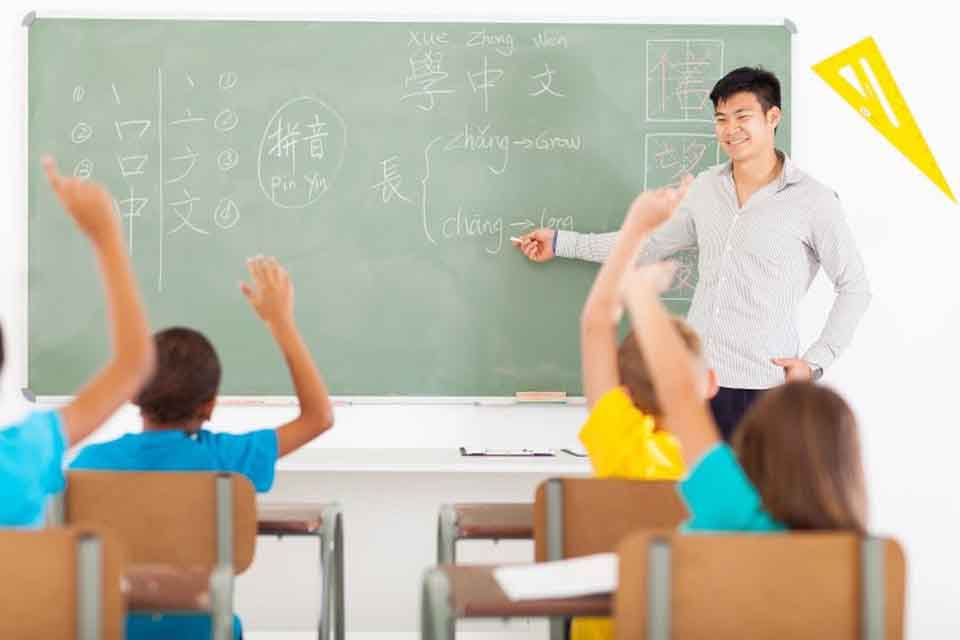
Approximately 5 million students in the United States are English language learners, and the number of English language learners (ELLs) in the US public school system continues to rise steadily, especially in more urbanized school districts.
According to the National Center for Education Statistics (NCES), students who speak English as a second language are more likely to struggle with academics, and only about 67 percent will graduate from public high school in four years—whereas the average for all students is 84 percent. ELL students can better develop their English proficiency and close the gap in achievement by participating in language assistance programs or bilingual education programs, the NCES explains.
The benefits of bilingual education can begin with students in elementary school and follow them throughout their lives. Education’s impact can lead to a variety of outcomes depending on whether ELL students learn English in a monolingual or bilingual environment. Educators in diverse classrooms or working as school leaders should consider the benefits of bilingual education when creating curricula and establishing desired student learning outcomes.

What Is Bilingual Education?
While bilingual education can take many forms, it strives to incorporate multiple languages into the process of teaching. For example, since there is such a large Spanish-speaking population in the United States, many primary and secondary school students can benefit from educational environments where they are learning in both English and Spanish.
Bilingual education can often be the most effective when children are beginning preschool or elementary school. If children grow up speaking Spanish as their primary language, it can be difficult for them to be placed in English-speaking elementary schools and be expected to understand their teachers and classmates. In a bilingual classroom, however, young students can further establish their foundation of Spanish as well as English, better preparing them for the rest of their education.
Of course, this works for students who begin school speaking any language as their primary language. Children whose parents have come to the United States from another country may have limited English skills when they first begin elementary school. Teachers working in bilingual education classrooms will balance their use of two languages when teaching math, science, history, and other subjects to help these students develop a stronger foundation of their first language as well as English as their second language.
Academic Benefits
Students can benefit in many ways from participating in bilingual education programs or classrooms. Some of the benefits of bilingual education relate to intellect. For example, research has shown that students who can speak and write in multiple languages have cognitive advantages over their monolingual peers. Those who learn a second or third language from a young age are able to develop communication skills and a higher degree of literacy. Children who grow up in bilingual environments develop a keen awareness of how language works and have a stronger foundation for learning additional languages in the future.
Students can also benefit academically from bilingual education. Students who pursue higher education are typically required to take a foreign language at the collegiate level, so those who have been exposed to bilingual educational environments before college—and speak two or more languages—have an advantage over their peers. They can advance in their studies and feel comfortable with multiple communities of students on their campuses.
Students who are exposed to multiple languages throughout high school and college can also have long-term career benefits. Their proficiency in multiple languages is an advantage when they graduate and enter the workplace as professionals. Every industry has a need for effective communicators who can speak multiple languages to meet the needs of the growing number of English language learners in the United States. International operations also have a great need for professionals who can speak multiple languages and represent US-based organizations and companies.
Growth beyond Academics
While there are many benefits of bilingual education related to school and work, bilingual education programs also have a huge impact on students’ cultural and social growth. Children who grow up speaking English as a second language often come from culturally diverse backgrounds. Incorporating cultural education in the classroom can help create enriching academic experiences for all students.
Exploring multiple languages in the classroom provides a foundation for cultural education that allows students to learn and grow alongside classmates from a different cultural background. As a result, students learn to become more adaptable and more aware of the world around them.
To encourage the academic and cultural development of students in bilingual education settings, teachers should have a strong foundation in education and leadership. They should demonstrate a passion for teaching as well as an understanding of how language and culture work together in their students’ academic journeys. Educators should be aware of the role that policies play in the educational environments they cultivate and have an understanding of how to best represent their students’ cultural backgrounds.
Pursue a Master of Arts in Teaching or Master of Education in Education Policy and Leadership
To implement the best teaching practices in bilingual education classrooms, teachers should be equipped with a foundation in transformational leadership and cultural awareness. To that end, teachers looking to have a meaningful impact on the lives of their students can further their own education and pursue an advanced degree in education policy and leadership. Through programs like American University’s Master of Arts in Teaching and Master of Education in Education Policy and Leadership , educators can broaden their worldviews, engaging in topics such as education law and policy, quantitative research in education, and educational leadership and organizational change.
Culturally Responsive Teaching Strategies: Importance, Benefits & Tips
EdD vs. PhD in Education: Requirements, Career Outlook, and Salary
Transformational Leadership in Education
Bilingual Kidspot, “5 Amazing Benefits of a Bilingual Education”
Learning English, “Number of English Learners in US Schools Keeps Rising”
National Center for Education Statistics, “Digest of Education Statistics”
National Center for Education Statistics, “English Language Learners in Public Schools”
Pew Research Center, “6 Facts About English Language Learners in U.S. Public Schools”
USA Today, “More US Schools Teach in English and Spanish, But Not Enough to Help Latino Kids”
Request Information
Bilingual Education and America’s Future: Evidence and Pathways
This paper looks at the next 25 years of education and policy making regarding students classified as English learners (EL). Given the strong research evidence on the benefits of bilingual education and need to address barriers to opportunity experienced by English learners, this paper strengthens the case for federal, state and local education policy and action that looks toward the implementation of bilingual education as the standard service--rather than exception--for EL-classified students.
- Events Calendar
- Featured Story
Bilingual Education Is America’s Future
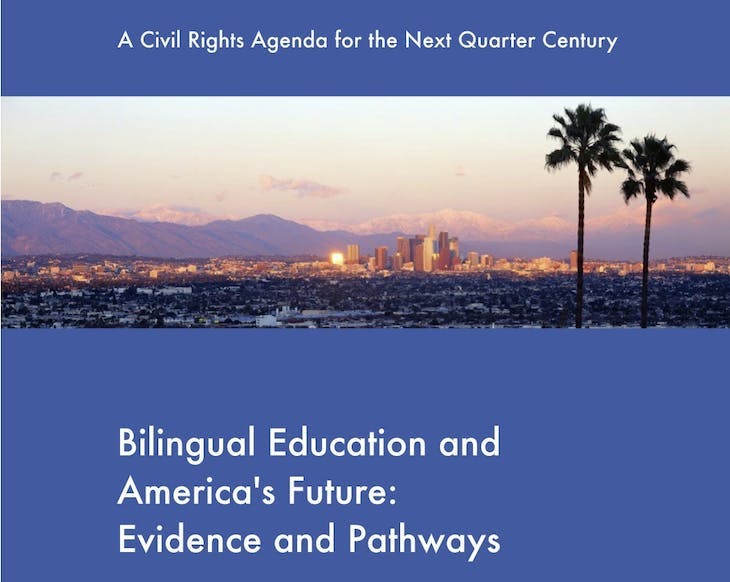
New report published by the UCLA Civil Rights Project makes the case for bilingual education as the standard of instruction
Synthesizing rigorous research illustrating the benefits of bilingual education and citing growing interest in and demand for bilingual and biliteracy education programs for all students, a new report published by the UCLA Civil Rights Project/Proyecto Derechos Civiles advocates for the establishment of bilingual education as the standard program of instruction for students classified as English learners (EL) and outlines federal, state and local policies needed to achieve that standard.
At a time of growing interest and support for bilingual education opportunities, the paper, “Bilingual Education and America’s Future: Evidence and Pathways,” underscores the reality that the United States lags behind most other nations where bilingual education is the norm and that many English learner-classified students in the U.S. are underserved. These students are enrolled in schools that often do not provide full, equitable access to the standard curriculum, nor the opportunity to develop the language they already know, two problems that bilingual programs address. The report offers strong evidence of the benefits of bilingual education and a growing commitment to education policymaking that addresses barriers to opportunity experienced by EL students. The report's authors contend that now is an opportune moment to expand bilingual education and establish bilingual and biliteracy education as the standard for instruction for all students, but especially for those who arrive at school with a language other than English.

- Patricia Gándara
“Careful and sophisticated studies produced over the last decades consistently find that bilingual education yields numerous advantages for the students who are fortunate enough to receive it,” says Patricia Gándara, co-director of the UCLA Civil Rights Project/Proyecto Derechos Civiles. “Given increasing interest and support, from both families and policymakers, this is the moment to expand bilingual education and build a stronger foundation for these programs.”
The report's call for more expansive access to bilingual education is grounded in evidence of the benefits of bilingualism and biliteracy for students and the larger society. The researchers detail the academic benefits of bilingual education, including superior achievement outcomes. These include English language development benefits, such as a greater likelihood of reclassification or exit from English Learner services. The report also highlights the benefits of home language literacy and proficiency and cites a growing body of research that bilingual education supports more positive social-emotional and sociocultural outcomes for EL-classified students. Importantly, the study shows evidence of greater family engagement in school, success in secondary schools and readiness for higher education.
The research also highlights the growing grassroots momentum and political support for bilingual education, including increased demand for programs that can serve all students who want it.
At the same time, the paper also identifies key challenges to expansion, including a shortage of bilingual educators and the need for sustained funding to build capacity. The authors recommend specific policy supports at the federal, state, and local levels to establish bilingual education as the standard program of instruction for English learner-classified students.
“Bilingual education is the best way to support EL-classified students and it's up to educators and policymakers to ensure all students receive this support, " said Manuel Vazquez Cano, a principal researcher at Education Northwest and a co-author of the report.
“Expanding access to bilingual education, to the point where bilingual education becomes the standard service for English learners rather than an exception, is grounded in research on what works for the nation's multilingual learners and aligned with national priorities of promoting bilingualism and biliteracy,” adds Lorna Porter , a research associate at WestEd and co-author. “While the change will not happen overnight, coordinated local, state, and federal actions can begin to move towards an education system that values, celebrates, and fosters bilingualism and biliteracy for all students.“
“ Bilingual Education and America’s Future: Evidence and Pathways,” is published by the UCLA Civil Rights Project/Proyecto Derechos Civiles, as part of a new series of research papers, A Civil Rights Agenda for the Next Quarter Century . The report’s authors include Lorna Porter, a Research Associate at WestEd, Manuel Vazquez Cano , a principal researcher at Education Northwest and graduate student at the University of Oregon, and Ilana Umansky, an associate professor in the College of Education at the University of Oregon. The full report and executive summary can be found on the website of the Civil Rights Project at https://civilrightsproject.ucla.edu/research/k-12-education/language-minority-students/bilingual-education-and-americas-future-evidence-and-pathways.
- Bi-literacy
- Bilingual Education
- Bilingualism
- Civil Rights Project/Proyecto Derechos Civiles
- Knowledge that Matters
Key Concepts in Bilingual Education
- Reference work entry
- First Online: 04 January 2017
- Cite this reference work entry

- Wayne E. Wright 5 &
- Colin Baker 6
Part of the book series: Encyclopedia of Language and Education ((ELE))
6206 Accesses
40 Citations
1 Altmetric
This chapter provides a broad overview of historical and contemporary key concepts in bilingual education while noting the ambiguous definitions and varying purposes and sometimes conflicting aims as driven by ideologies and politics. Major contributions and work in progress are considered through traditional program models and efforts to extend bilingual education to varying student populations and global contexts. Problems associated with determining effectiveness are discussed, along with challenges to the traditional concepts of program models based on new scholarship challenging monolingual perspectives and encouraging multilingual understandings of bilingualism as dynamic classroom practices that do not insist on the strict separation of languages. We conclude with a discussion of future directions in bilingual education related to school, classroom, and student-level concepts.
This is a preview of subscription content, log in via an institution to check access.
Access this chapter
- Available as PDF
- Read on any device
- Instant download
- Own it forever
- Available as EPUB and PDF
- Durable hardcover edition
- Dispatched in 3 to 5 business days
- Free shipping worldwide - see info
Tax calculation will be finalised at checkout
Purchases are for personal use only
Institutional subscriptions
Arias, B. (2015). Parent and community involvement in bilingual and multilingual education. In W. E. Wright, S. Boun, & O. García (Eds.), Handbook of bilingual and multilingual education (pp. 282–298). Malden: Wiley-Blackwell.
Google Scholar
Baker, C. (2011). Foundations of bilingual education and bilingualism (5th ed.). Bristol: Multilingual Matters.
Beam-Conroy, T., & McHatton, P. A. (2015). Bilingual education and students with dis/abilities and exceptionalities. In W. E. Wright, S. Boun, & O. García (Eds.), Handbook of bilingual and multilingual education (pp. 372–390). Malden: Wiley-Blackwell.
Celic, C. & Seltzer, K. (2013) Translanguaging: A CUNY-NYSIEB Guide for Educators . Retrieved from http://www.nysieb.ws.gc.cuny.edu/files/2013/03/Translanguaging-Guide-March-2013.pdf
Cenoz, J., Genesee, F., & Gorter, D. (2014). Critical analysis of CLIL: Taking stock and looking forward. Applied Linguistics, 35 (3), 243–262.
Article Google Scholar
Feng, A., & Adamson, B. (2015). Contested notions of bilingualism and trilingualism in the People’s Republic of China. In W. E. Wright, S. Boun, & O. García (Eds.), Handbook of bilingual and multilingual education (pp. 484–494). Malden: Wiley-Blackwell.
Ferguson, C. A., Houghton, C., & Wells, M. H. (1997). Bilingual education: An international perspective. In B. Spolsky & R. Cooper (Eds.), Frontiers in bilingual education (pp. 159–174). Rowley: Newbury House.
Flores, N., & Beardsmore, H. B. (2015). Programs and structures in bilingual and multilingual education. In W. E. Wright, S. Boun, & O. García (Eds.), Handbook of bilingual and multilingual education (pp. 205–222). Malden: Wiley-Blackwell.
García, O. (2009). Bilingual education in the 21st century: A global perspective . Malden: Wiley-Blackwell.
Guo, Z. (2014). Young children as intercultural mediators . Bristol: Multilingual Matters.
Hamayan, E., Marler, B., Sanchez-Lopez, C., & Damico, J. (2013). Special education considerations for english language learners: Delivering a continuum of services (2nd ed.). Philadelphia: Caslon Publishing.
Kharkhurin, A. V. (2012). Multilingualism and creativity . Bristol: Multilingual Matters.
Kharkhurin, A. V. (2015). Bilingualism and creativity: An educational perspective. In W. E. Wright, S. Boun, & O. García (Eds.), Handbook of bilingual and multilingual education (pp. 38–55). Malden: Wiley-Blackwell.
Koda, K., & Zehler, A. M. (2008). Learning to read across languages: Cross-linguistic relationships in first- and second-language literacy development . New York: Routledge.
Lewis, G., Jones, B., & Baker, C. (2012a). Translanguaging: Developing its conceptualisation and contextualisation. Educational Research and Evaluation, 18 (7), 655–670.
Lewis, G., Jones, B., & Baker, C. (2012b). Translanguaging: Origins and development from school to street and beyond. Educational Research and Evaluation, 18 (7), 641–654.
Lindholm-Leary, K. J. (2001). Dual language education . Clevedon: Multilingual Matters.
Reagan, T. (2015). Bilingual Deaf education. In W. E. Wright, S. Boun, & O. García (Eds.), Handbook of bilingual and multilingual education (pp. 391–408). Malden: Wiley-Blackwell.
Valdés, G. (1997). Dual-language immersion programs: A cautionary note concerning the education of language-minority students. Harvard Educational Review, 67 (3), 391–429.
Valdés, G. (2003). Expanding definitions of giftedness: The case of young interpreters from immigrant communities . Mahwah: Lawrence Erlbaum.
Walqui, A., & van Lier, L. (2010). Scaffolding the academic success of adolescent English language learners: A pedagogy of promise . San Francisco: WestEd.
Wright, W. E. (2015). Foundations for teaching English language learners: Research, theory, policy, and practice (2nd ed.). Philadelphia: Caslon Publishing.
Download references
Author information
Authors and affiliations.
College of Education, Department of Curriculum and Instruction, Purdue University, 100 N. University Dr., West Lafayette, IN, 47907, USA
Wayne E. Wright
School of Education, Bangor University, Normal Site, Bangor, Wales, LL57 2PZ, UK
Colin Baker
You can also search for this author in PubMed Google Scholar
Corresponding author
Correspondence to Wayne E. Wright .
Editor information
Editors and affiliations.
The Graduate Center, The City University of New York, New York, New York, USA
Ofelia García
Faculty of Education, The University of Hong Kong, Pokfulam Road, Hong Kong
Angel M. Y. Lin
Faculty of Education and Social Work, The University of Auckland, Auckland, New Zealand
Stephen May
Rights and permissions
Reprints and permissions
Copyright information
© 2017 Springer International Publishing AG
About this entry
Cite this entry.
Wright, W.E., Baker, C. (2017). Key Concepts in Bilingual Education. In: García, O., Lin, A., May, S. (eds) Bilingual and Multilingual Education. Encyclopedia of Language and Education. Springer, Cham. https://doi.org/10.1007/978-3-319-02258-1_2
Download citation
DOI : https://doi.org/10.1007/978-3-319-02258-1_2
Published : 04 January 2017
Publisher Name : Springer, Cham
Print ISBN : 978-3-319-02257-4
Online ISBN : 978-3-319-02258-1
eBook Packages : Education Reference Module Humanities and Social Sciences Reference Module Education
Share this entry
Anyone you share the following link with will be able to read this content:
Sorry, a shareable link is not currently available for this article.
Provided by the Springer Nature SharedIt content-sharing initiative
- Publish with us
Policies and ethics
- Find a journal
- Track your research

TOP > Papers & Essays > Language Development & Education > Understanding Bilingual Education 1: Analyzing Purposes of Bilingual Education
Papers & Essays
Understanding bilingual education 1: analyzing purposes of bilingual education.
Understanding Bilingual Education 1. Analyzing Purposes of Bilingual Education (This paper) 2. Analyzing Types of Bilingual Education 3. Analyzing Cases of Bilingual Education
Introduction to Bilingual Education
Bilingualism is the study of languages in contact, typically in situations where people from different linguistic and cultural backgrounds share the same space. Bilingualism was analyzed into four levels in another paper : individual, family, societal, and school levels (McCarty, 2010b). Bilingual education is bilingualism at the school level. It is not to be confused with bilingual child-raising (Pearson, 2008; McCarty, 2010a), such as speaking two languages to an infant systematically at home, which is bilingualism at the family level. Bilingual education should involve teaching in two or more languages in a school, that is, more than one language as the medium of instruction for students to learn regular school subjects.
However, other levels of bilingualism, including their cultural dimensions, do influence bilingual education. All people have a cultural identity and a linguistic repertoire, the languages they can use to some extent. Grosjean (1982) explains that "language is not just an instrument of communication. It is also a symbol of social or group identity, an emblem of group membership and solidarity" (p. 117). As a result, the attitudes people have toward different languages tend to reflect the way they perceive members of the other language groups.
Furthermore, languages have a relative status or value as perceived by the majority of a society. Languages are regarded as useless or attractive according to the economic power or cultural prestige attributed to them by the mainstream of a society, which tends to privilege national or international languages. Native languages of children of immigrants may seem to be of no use, and tend to be disregarded, while languages that are valued by the mainstream society tend to be used in education. However, Sweden has offered educational support in 100 languages (Yukawa, 2000, p. 47), while Japan's limited support has been nearly all in the Japanese language. This shows that it is not a matter of wealth but of the dominant way of thinking in the nation. The contrast in treating minority students can be as stark as a choice between assimilation and multicultural policies (Grosjean, 1982, p. 207).
Various Purposes of Bilingual Education
There are "varying aims of bilingual education" because it "does not necessarily concern the balanced use of two languages in the classroom. Behind bilingual education are varying and conflicting philosophies and politics of what education is for" (Baker, 2001, p. 193). These different purposes then lead to various actual school systems of monolingual or bilingual education. Ten typical aims of bilingual education were cited by Baker:
As can be seen from the above list, there are many and diverse purposes for conducting school programs that are called bilingual education, according to the way of thinking of decision makers in different cultures. Grosjean summarizes how implicit government policies affect the languages used in education: "Depending on the political aims of the authorities (national or regional), some minority groups are able to have their children taught in their own language, while others are not" (1982, p. 207). "If the government's aim is to unify the country, assimilate minorities, or spread the national language, more often than not minority languages will not find their place in education" (p. 207). Whereas, "if a society wants to preserve ethnic identities, give equal status to all languages and cultures in the country, revive a language, teach a foreign language more efficiently, or make its citizens bilingual and bicultural, it will often develop educational programs that employ two languages and are based on two cultures" (p. 215).
Conclusion to the First Paper on Bilingual Education
As Grosjean identifies the key issues above, the concerns of bilingualism researchers and practitioners shine through. A society may be judged by how it treats its minorities or protects the human rights of its vulnerable members. Some purposes for selecting languages to use in education may be better than others from both ethical and pedagogical perspectives. In any case, analyzing the diverse purposes behind the languages that appear in schools can deepen the understanding of resulting educational systems in the world, and possibly suggest improvements in terms of bilingual education.
- Baker, C. (2001). Foundations of bilingual education and bilingualism (3rd ed.). Clevedon, UK: Multilingual Matters.
- Grosjean, F. (1982). Life with two languages. Cambridge, Massachusetts: Harvard University Press.
- McCarty, S. (2010a). Bilingual child-raising possibilities in Japan. Child Research Net: Research Papers.
- McCarty, S. (2010b). Bilingualism concepts and viewpoints. Child Research Net: Research Papers.
- Pearson, B.Z. (2008). Raising a Bilingual Child. New York: Living Language.
- Yukawa, E. (2000). Bilingual education in Sweden. In S. Ryan (Ed.), The best of Bilingual Japan, (pp. 45-47). Osaka: Japan Association for Language Teaching (JALT) Bilingualism SIG.
- Understanding Bilingualism 1: What it Means to Be Bicultural
- Understanding Bilingualism 2: Bilingualism Concepts and Viewpoints
- Understanding Bilingualism 3: Bilingual Child-Raising Possibilities in Japan
- Educational Support for Children with Foreign Backgrounds: Impact of Parents' Japanese Language Skills on Children's Japanese Proficiency and Future Careers
- Assessment of Lexical Development in Preschool Children with Brazilian Roots and Attempts to Support Language Development Based on Their Heritage Language
- Japanese Education for Children Who Cannot Speak Japanese
Latest Posts
- As We Enter 2024
- [Snuggling Up to Our Differences] Episode 6: Sitting in a Chair and Listening--Good Manners?
- [A Gentle World through the Perspective of Children with Developmental Disabilities] Episode 3: Takuya-kun Having Trouble with Friendships―The World Surrounding Children with ASD
- The Wannsee Conference
- [South Korea] Current Situation and Issues of Inclusive Education for Preschool Children in South Korea - II
- [Video] Thoughts on Inclusive Education (3)
- [Video] Thoughts on Inclusive Education (2)
- Promoting Children's Resilience for Nurturing Competent Citizens for the Future
- [Perspectives of Traditional Culture of the Matrilineal Mosuo of Lugu Lake] Part 6: Mosuo Women's Choice of Marriage in Different Times
- Social Sensitivity to Sexual Abuse
- Early Childhood
- Elementary, Junior High, High School, and University
- International Comparisons
- Digital Media and Children
- Children's Rights and Well-being
- New Directions
- Full Paper Archive
- Research Data
- Latest Children's Issues
- Childrearing and Education
- About this Project
- Interactive Activities
- CRN History
- Publications
Request More Info
Fill out the form below and a member of our team will reach out right away!
" * " indicates required fields
What Is Bilingual Education? [+ Career Guide]
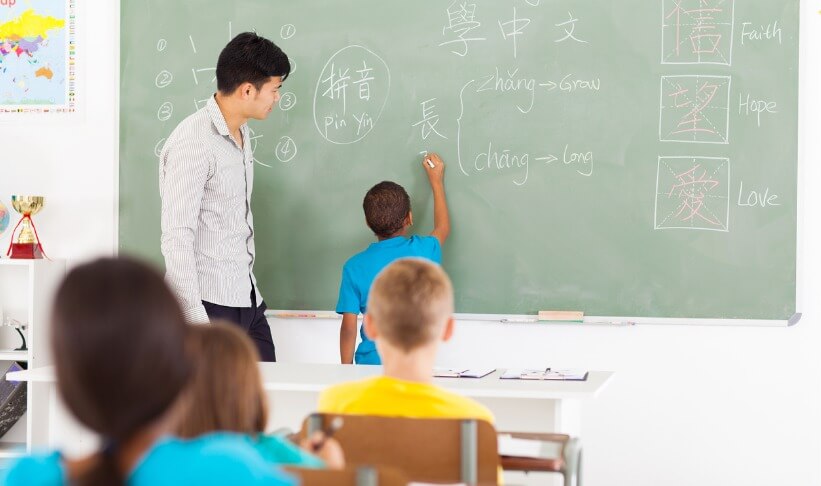
What Is Bilingual Education?
How does bilingual education work, types of bilingual education, the importance of bilingual education, benefits of bilingual teachers in schools, bilingual education careers, how to become a bilingual educator.
Bilingual education is the delivery of academic material in two languages, one of which is usually the students’ native language. Students of all ages enroll in schools and learning environments where the primary language is different from their native language; in order to keep these students on the same academic timeline as their peers, schools may offer a bilingual education program that makes course content more accessible while students learn a new language.
Most bilingual or dual language education in the United States is delivered in Spanish and English , but Mandarin Chinese, French, German and Vietnamese dual language programs are gaining traction. The U.S. has never declared an official language, but since 78.5 percent of the population speaks English at home, it is considered the unofficial “native” tongue. As such, most bilingual education programs in the U.S. focus on helping students develop proficiency in English . This is why bilingual students in America are often referred to as English Language Learners (ELL), or simply English Learners (EL).
There are several different types of bilingual education programs, the format of which varies depending on the end goal.
Bilingual education programs were first introduced in the U.S. in the mid-17th century , as a way to help Polish immigrants assimilate to the American manufacturing industry. Today, dual language programs are predominantly used for a similar purpose, though the goals have expanded to helping non-English speakers excel academically and even teaching native English speakers a new language.
In grade schools, bilingual education programs incorporate both the students’ native language (the partner language) and English in varying proportions :
50/50: English and the partner language are used equally throughout the class, schoolday, semester or program length. This model is common for children at the elementary school level, beginning in kindergarten or first grade and potentially continuing into middle and high school if needed. Most children who enter 50/50 bilingual programs before 7 years of age are much more likely to become proficient in the new language than older students, if enrolled in the program consistently.
90/10: This format is used by both non-English speakers and native English-speaking students to learn a new language. Eighty to 90 percent of the course content is delivered either in English or the partner language, with some classes offered entirely in the partner language.
100 percent immersion: Second language immersion programs use a partner language (typically not English) for all communications, both in and outside the classroom.
Dual language programs are often found in U.S. schools located in neighborhoods with large immigrant or non-English speaking populations, while immersion programs are typically found in schools with a majority English-speaking student body.
Bilingual education programs differ according to the ultimate goal. Do students need to become proficient in English to communicate with their teachers and peers, or do they wish to learn a new language for academic enrichment or expanded career opportunities? Do they want to maintain fluency in both their native language and English? There are programs available for all of these language learners.
See the chart below for a breakdown of the different types of bilingual education programs, using English and Spanish as example languages. Also included are immersion and heritage language programs, which provide slightly different opportunities for academic and cultural enrichment.
As you can see, bilingual education can be classified in multiple ways; for example, a student can be enrolled in a dual language, one-way, transitional, early exit program.
Above all, bilingual education affords all students the opportunity to earn an education, no matter what language they speak. Being able to access their native language for support ensures that non-English speakers can progress academically alongside their English-speaking peers.
In addition to educational equity, dual language programs can foster:
- Multilingualism and multiliteracy
- More effective communication skills
- Enhanced awareness of linguistic and cultural diversity
- Greater connection to a community of peers
- Higher levels of academic achievement
- Increased cognitive function
- Broader cultural representation and equity in schools
- Diverse opportunities for students to thrive in a global job market
- Greater cultural empathy
- An expanded sense of cultural identity
The best way to support bilingual learners is to have bilingual teachers in schools, especially schools in areas with high populations of non-English speakers. When teachers can be a resource to learners in multiple languages, they may observe the following in their students:
- Improved academic performance
- Better communication skills
- Increased ability to think creatively, recognize patterns and solve problems
- Enhanced linguistic and cultural awareness
- Greater ability to apply fundamental concepts to novel situations
- Improved social skills
- Greater confidence, self esteem and a more positive outlook
When a bilingual student successfully graduates with proficiency or fluency in English, they may have access to a greater range of job opportunities in the U.S. and beyond.
Students who benefit from dual language education programs may find that they wish to become bilingual educators themselves. Fortunately, bilingual or multilingual teachers are in high demand , as learning environments across the country become increasingly more multicultural and inclusive . Now more than ever, American students need teachers who can teach the whole child, addressing not only their academic needs but their social, emotional and cultural needs .
Since demand is high, there are often financial benefits to becoming a bilingual teacher. According to Zippia , the average annual salary for a bilingual teacher is $51,770, while the average starting salary for a teacher in the U.S. is $41,955. Some schools will even offer stipends or bonuses to teachers who can add bilingual instruction to their educator skill set.
Possible careers for bilingual teachers who have earned a Bachelor’s degree or Master of Education include*:
- Job description: Instructs non-native English speakers in the fundamentals of the English language.
- Salary: $52,701
- Job description: Serves as a classroom aid to students whose native language is not English, relaying course content and instructions if and when the student lacks understanding due to a language barrier.
- Salary: $36,519
- Job description: Teaches a new language to students primarily for academic enrichment purposes.
- Salary: $53,918
- Job description: Designs educational curriculums, introduces improvements to teaching methods, develops educational programs and events and/or coordinates educational services for multilingual students.
- Salary: $49,139
- Job description: Develops educational programs and curricula that accounts for students who currently or will speak multiple languages.
- Salary: $54,176
- Job description: Serves as additional classroom support to multilingual students with special needs, including academic, physical, personal and social-emotional needs.
- Salary: $31,394
- Job description: Provides instruction in a specialized subject in multiple languages. Requires in-depth knowledge of the applicable subject, in addition to bilingual fluency.
- Salary: $41,000–$64,000+
Of course, most of these professions exist without a bilingual element, but employers will often advertise open positions with an explicit bilingual requirement.
*All salaries are national averages generated by Zippia.com as of November 2022.
If you are not already bilingual, start learning and practicing as soon as you can, even if you don’t yet have the proper degree qualifications to become a licensed teacher.
To become any kind of educator in a public school, you will need a master’s degree or, at the very least, a Bachelor’s degree, preferably in education. A degree in a second language is also ideal preparation. You will also need to become licensed to teach (at least in public schools) in your preferred state, and possibly hold a certification in teaching in a second language . In certain cases, such as in high-need areas or amid teacher shortages, there are alternative routes to teaching certification that don’t require a bachelor’s or master’s degree in education.
If you are ready to earn your master’s degree, you’ll need to decide which type of education degree will help you achieve your goals. A Master of Education (MEd) is typically designed for current educators to expand their pedagogical skill sets in and beyond the classroom , such as in school leadership or curriculum design. A Master of Arts (MA) provides new or aspiring teachers with practical skills they can use in the classroom. Both degrees offer specializations , including some with ESL instruction, and both can incorporate a field work element. For this component, aspiring bilingual educators can request placement in a school with a high population of non-native English speakers or a robust dual language program.
Once you earn your degree, become licensed to teach (if you are not already) and start your job search, be sure to include bilingual proficiency and instruction on your teaching resume. As previously stated, bilingual professionals are in high demand in nearly all industries, so highlighting this skill set will catch any potential employer’s eye.
As you explore teaching opportunities, be sure to take advantage of professional organizations and networks that support bilingual educators:
- National Association for Bilingual Education (NABE) : A non-profit membership organization dedicated to pursuing educational equity and academic excellence for bilingual/multilingual students. NABE works to influence, support and create policies, programs, research, pedagogy and professional development that serves both multilingual students and bilingual/dual language education professionals.
- TESOL (formerly Teachers of English to Speakers of Other Languages): The largest international association of professionals dedicated to advancing the quality of ESL education. Before non-native English speakers can teach English, they must earn their TESOL certificate .
The most valuable resource for entering bilingual education is other educators ! Find fellow professionals who work in a bilingual setting and ask them how they got to where they are. You may also wish to connect with faculty at a university that offers education degrees to determine the right path forward.
Ready to take that step? Download the free guide below to see why an MEd might be the ideal move.
Be Sure To Share This Article
- Share on Twitter
- Share on Facebook
- Share on LinkedIn
Top 11 Reasons to get Your Master of Education Degree
Free 22-page Book

- Master of Education
Related Posts

What is Bilingual Education?

What is the definition of bilingual education?
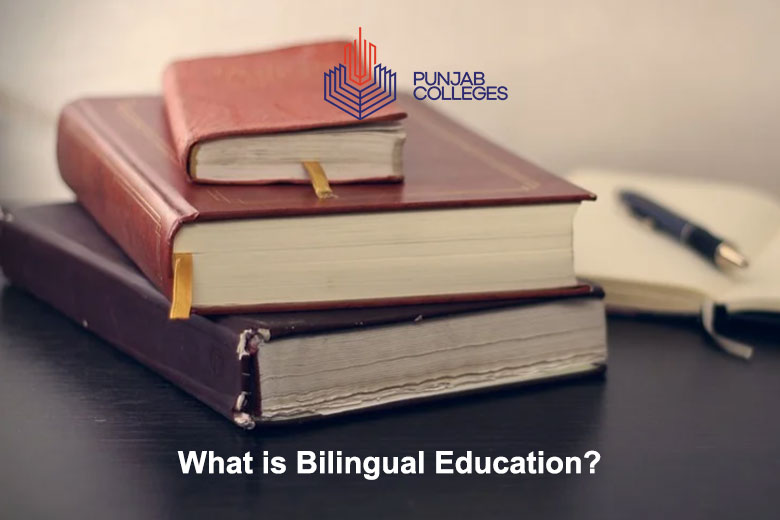
What is Bilingual Education? Bilingual education has gained ground in recent years. In this post, we address what it consists of, its main advantages, and challenges.
In recent years, the number of schools that have implemented integrated learning programs for content and foreign language has increased considerably. These models of bilingual education, or multilingual in those are helpful in those communities with co-official languages. These offer advantages and challenges to both teachers and students. Modality consists of its main advantages and challenges for the training of students.
What is bilingual education?
We speak of bilingual education in those cases in which in a community, two languages of different states are used. The minority language is introduced into the school and resources are provided for its teaching.
It depends on the roles played by the different languages and the objectives pursued. Different types of programs or models of bilingual education are usually distinguished. In the transitional or assimilationist model, the minority language is used as a means of instruction.
It is used during the first years and later gradually replaced by the majority or dominant language. The objective is, therefore, to facilitate the student’s adaptation to the demands of the educational system in a society. That does not promote bilingualism, immersion teaching.
The pluralist or maintenance model, on the other hand, encourages linguistic diversity. Also tries to eradicate negative social attitudes towards the minority language. In this type of program, the minority language is more important than the majority language. It is used in the school curriculum and is used as a medium of instruction. Not only in the initial stages, but also in the more advanced courses.
There is also a special type of bilingual education for speakers of the majority or dominant language, immersion teaching.
Bilingualism:
Are you interested in educating yourself completely in another language? And would you like to know the advantages of bilingual education and its disadvantages? Normally, you ask yourself this question due to the growing interest in acquiring high levels of knowledge of a language, especially English.
Surely you know many people who have received a bilingual education. And the advantages that it has been evident. Knowing a language is almost like a second mother tongue. Of course, this can open numerous doors in anyone’s work future. Even in the personal sphere because who wouldn’t want to spend a few years of their life in a foreign country? Or who doesn’t like to travel?

What is the purpose of bilingual education?
Bilingual Intercultural Education is the modality of the educational system that guarantees the constitutional right of native peoples to receive an education that contributes to preserving and strengthening their cultural elements, language, their worldview, and identity.
What are the types of bilingual education?
Native bilingualism: One who has a person because he is originally from a country but has foreign influences, which allows him to master both the language of his country and abroad. An example could be a child who lives in Pakistan and has an American father with whom he speaks English at home.
Acquired bilingualism: That which is acquired when someone with a mother tongue studies a foreign language until they know it and use it very well. For example, a child whose mother tongue is Urdu begins at a very young age to study English and ends up mastering this language over the years.
Benefits of bilingual language:
You must look at the advantages and disadvantages of bilingual education before making a decision. On the positive side, we can highlight the advantages of bilingual education on several points.
When choosing a bilingual center, doubts arise about its advantages and disadvantages. Does it help to improve the level of English? Does it affect the learning of other subjects? Does it affect the development and competence in the mother tongue? The answer to all these doubts will depend on the specific educational plan that each center implements, but we can extract a series of advantages that bilingual education offers students:
Linguistic competence: it is the most obvious benefit. But, in addition, this ability activates the brain’s networks and allows people to have a more open look and thought.
Professional competence: undoubtedly one of the reasons why many people choose bilingual education. With this type of education, professional possibilities multiply, being a quality that can make a difference with other candidates for a job.
Cognitive competence: being bilingual is much more than speaking two languages since it allows developing communication skills and provides mental flexibility.
Cultural competencies: a language is also culture, and that is precisely what is acquired together with linguistic competencies, breaking down cultural and mental barriers, and providing a broader vision of the world.
Why bilingual education is important?
My own experience as a bilingual student and educator gives me reason enough to strongly promote and support bilingual programs. Bilingual education is a powerful tool that educators use to carry out their mission to help New York City public school students become proficient in the English language.
These students with the help and support of their native language will be able to transfer their knowledge of the well-structured and meaningful language to the demands of the English language. Bilingual educators are contributing so that the child can also preserve his culture, values , and traditions to make his learning environment comfortable and pleasant. The child must feel that environment as his own so that he can feel the invitation made to learn to master two languages that will open the door to success.
Another important reason is related to my own experience of how bilingual education can make a big difference in people’s lives when they are allowed to do so through bilingual education programs.
Another important factor in bilingual education is the results in terms of academic achievement since the child can become well qualified to reach the learning levels required by the education department.
In the Dual Language Immersion programs, children become fluent in reading, writing, speaking, and understanding two languages simultaneously, making the child improve their levels in the tests required by the education system.
Below I will show some real results of work done with children from these two-language immersion programs where they have received instruction in two languages, native and English. Over the next few days or weeks, your progress is seen in both languages. Today we will take the example of a math lesson, the subject of which was somewhat complicated and difficult for first graders.
However, the teaching in their native language and the use of real situations from daily life helped them to understand and manage the use of fractions. The result was fantastic when all the students took their math test in English, where not only their knowledge was tested, but their understanding of fractions, and other mathematical concepts. Most of the students scored 100% on the fraction part. Students had the opportunity to transfer their knowledge learned in their native language to the English language.
Children through their experience in bilingual programs never lose focus and their primary goal of becoming proficient students of the English language, where they will have the ability to read, write, understand and express it orally. Similarly, each of them also understands the importance and meaning of being bilingual because they must master both languages with the same ability and dexterity.
Advantages and disadvantages of bilingual education?
As a general rule, people who have a bilingual education receive it from the earliest years of childhood, so it is the parents who make this decision. However, there are other options, such as studying a bilingual career at the university, which can also help you learn a foreign language more thoroughly.
In any case, and although it may not seem like it, bilingual education has advantages and disadvantages that you should know before embarking on this adventure. Would you like to know which ones are they? Keep reading!
Advantages of bilingual education:
- Students achieve communicative competence in the second language, in many cases at the level of a monolingual native.
- The introduction of a second language from the early formative stages favors the understanding of the speech acts and the culture of another language.
- Students grow up knowing cultures other than their own, they understand that they are part of a diverse society.
- Beyond linguistic competence, the use of another language is perceived as a professional skill.
- Greater selective attention and multitasking ability to be able to alternate two languages.
- Enhances attention, memory, and concentration.
- Easier to learn other languages.
- There is still a long way to go in bilingualism
Although language teaching in schools has been on the rise in recent years, there is still work to be done. The effective implementation of bilingualism requires time and adaptation of curricula, methodologies, and organization of schools, as well as adequate training of teachers.
Disadvantages of bilingual education:
It can be assumed that the disadvantages of bilingualism are related to (a) greater language difficulties in children with language problems, (b) decreased verbal fluency, and (c) interference between the two languages.
Analyzing bilingual education and its advantages and disadvantages. We can see some negative aspects that affect children above all. In this sense, many experts do not agree with this type of education since it is very likely that the person runs the risk of not reaching a satisfactory level in either of the two languages in which they are being trained. Hand in hand are the cognitive problems related to language that with a multilingual person multiplies by as many languages as the person masters.
Of course, if you wanted to acquire these skills as an adult, you would not have to face these inconveniences. So don’t think twice! Knowing bilingual education and its advantages and disadvantages, you are prepared to make the decision that you have been thinking about for so long and that it will open so many doors for you professionally.
Effectiveness of bilingual education:
The question what is bilingual education? and how is this effective? will be justified here. It gives the opportunity to the person to have expertise in the language skills. There are multiple languages that favour you in many ways.
English is the language that is used commonly in the schools and a popular part of the courses. French also has a great scope and getting common in educational institutions. So let’s talk about the French language that after English is taught in the courses. In the higher level, students have the option to choose a language as their elective subjects.
Who has French as a second language?
Who has French as a second language? French is the language of instruction to develop bilingual speakers; English-French. The most recent investigations have presented results positive studied more than a dozen sociolinguistic variables (about the phonology, lexicon, and morphsyntax of oral French) and concluded that students in immersion programs outperformed students who took normal French classes in these factors.
However, the results also showed that the language development of the immersion program speakers was considerably lower than that of native speakers of the same age. This is a common fact in this type of investigation. Swain has studied these Canadian programs for more than two decades.
One of his Major studies in 1985, which many consider key in language acquisition research, showed that immersion did not translate into acquisition. For many years that students were in immersion programs, their output not only did not match native speakers, but it was way below.
The possible causes of this lack of competence are investigated and conclude that production plays a crucial role in the acquisition of a language. Input is necessary but not enough. This is known as the ‘Output hypothesis’. Therefore, it can be concluded that one of the limitations of bilingual education is that for many students the second language becomes a ‘school phenomenon’.
These students are moderately proficient in second languages. But they do not use it outside the classroom. In short, research in Canada has shown positive and negative results of their immersion programs and has served as feedback to improve them. In addition, it has opened the door for other researchers to be developed in other countries and programs.
Some of them have been carried out in the European context with different results. However, the results seem to be repeated and it can be concluded that many students may not acquire native skills in all areas of the language.
This is partly to be expected since these bilingual programs tend to have a very restrictive social environment to practice the language and this means that students do not have use of social language stylistic appropriate because communication is limited to that of teacher-student.
Therefore, the lack of opportunities to practice the language spontaneously can be the cause of this performance difference; Research has shown that this is particularly true if, in class, the emphasis is on correction rather than developing communication skills. In these cases, students will probably understand the language (input) perfectly, but they will not produce it well (output).
Some programs have already started promoting improvements and developing other teaching techniques to change these results. Among them is that the teacher concentrates on the evaluation of the content and not on the grammatical execution.
In addition, researchers recommend increasing the group and collaborative work to increase linguistic competence while integrating the ‘focus on form’ approach when teaching content. Teachers have also been recommended to systematically give feedback to students on their development.
On the other hand, research is quite insistent that to develop a linguistic competence comparable to the native one students must have opportunities to practice the language spontaneously and with other native speakers on different cultural occasions. Programs in Wales have proposed weekend camps in which students use the language spontaneously with positive results.
Conclusion:
The questions, what is bilingual education? is pretty much clear and now we must conclude the facts here.
Language selection and alternation require additional attentional resources. However, the specific pattern of brain activity of each language depends on the use it. And probably on a variety of situational conditions.
Traditionally, the literature has tended to emphasize the negative consequences of bilingualism. Such as delayed language acquisition, increased interference, and decreased vocabulary in each language.
Over the past decades, however, the emphasis has shifted to the positive aspects of bilingualism. It includes metalinguistic awareness, cognitive flexibility, and cognitive control. Bilinguals can score higher on a variety of both verbal and non-verbal tasks.
When it comes to two active languages and frequent changes are required, interference and decrease in verbal fluency can be anticipated. Conversely, language represents the most important instrument of human cognition.
However, the possibility of re-sorting the two different languages can increase the cognitive potentials of an individual. Poor learning of one or both languages can cause a negative effect on students. But solid learning of both languages can result in important cognitive and academic advantages.
Learn, speak solid!
Read more Articles:
What Education Does for the Mind?
What is Classical Education?
Leave a Reply Cancel reply
Your email address will not be published. Required fields are marked *
Save my name, email, and website in this browser for the next time I comment.
Cyber Monday Sale 70% Off - Start Your Free Trial - LIMITED TIME

The Power of Bilingualism: Advantages in Education and Career

Bilingualism, the ability to speak more than one language fluently, has become increasingly relevant in today's interconnected world. Being bilingual offers a wealth of advantages in both education and career, shaping individuals' cognitive abilities, language skills, and cross-cultural communication.
In this article, we will delve into the power of bilingualism and explore its profound impact on personal and professional growth. Additionally, we will discuss effective strategies for language learning , providing insights into how individuals can best acquire a second language.
By the end of this quick guide, you will understand the transformative potential of bilingualism and how it can shape your educational journey and career prospects.

Table of Contents
What does it mean to be bilingual, the benefits of being bilingual, improved cognitive abilities, increased cross-cultural communication, educational and professional opportunities overseas, how to learn a second language, faqs about bilingualism and its advantages.

Bilingualism refers to the ability of an individual to speak and understand two or more languages fluently . It is the state of being proficient in more than one language, allowing for effective communication and comprehension in multiple linguistic contexts.
Bilingual individuals, such as these celebrities , possess the skills to switch between languages effortlessly, demonstrating fluency and proficiency in both their native language and the additional language(s) they have acquired.
Bilingualism encompasses high levels of proficiency in reading, writing, listening, and speaking multiple languages. Now, let's take a look at the benefits of knowing a second language (or a third, fourth, or fifth language!).

The ability to speak a second language fluently provides a wealth of advantages to children and adults alike. From educational benefits such as improved cognitive abilities to career advantages like being able to communicate respectfully with people from other cultures, bilingual people are blessed with significant life advantages.
Let's explore the various benefits of being able to speak multiple languages.

Bilingualism offers a wide array of cognitive benefits, profoundly impacting your cognitive abilities. These advantages can open doors in the worlds of work and education.
Bilingualism has been found to enhance memory and attention span. The constant mental exercise of switching between languages strengthens the brain's cognitive processes, resulting in improved memory formation and retrieval. Moreover, bilingual individuals exhibit enhanced attention control, allowing them to effectively filter out irrelevant information and maintain focus on the task at hand.
As you can imagine, this will set a bilingual individual ahead of a monolingual peer within an educational or professional setting. Being bilingual also fosters superior problem-solving skills by encouraging flexible thinking and the ability to consider multiple perspectives.
Bilingual individuals often exhibit cognitive flexibility that enables them to switch between different language systems effortlessly. This cognitive flexibility extends beyond language processing and influences other cognitive domains, such as attentional control and mental flexibility.
Finally, when you can speak a second, third, or fourth language, you develop excellent language skills . You become much more adept in the grammar of your native language and you foster fantastic communication skills. This is a benefit both in the world of work and education, as you will become more linguistically advanced and able to communicate very efficiently.

Another of the remarkable benefits of bilingualism is its profound influence on cross-cultural communication. By speaking more than one language, individuals gain a unique advantage in navigating diverse cultural landscapes and bridging communication gaps.
Speaking multiple languages facilitates cross-cultural communication by enabling individuals to understand and connect with people from different backgrounds.
Bilingual individuals possess a deeper appreciation and knowledge of other cultures , as language is intricately intertwined with cultural nuances, idioms, and customs. This understanding allows them to navigate social interactions with ease and sensitivity, fostering meaningful connections with people from diverse backgrounds.
Moreover, bilingualism holds immense importance in linguistically diverse societies and communities . In such settings, whether it be a school, office, or local community, being able to communicate in multiple languages fosters inclusivity and breaks down language barriers.
Beyond facilitating communication, bilingualism plays a pivotal role in fostering empathy, tolerance, and global citizenship . By actively engaging with different languages and cultures, bilingual individuals develop a broader worldview and gain a deeper appreciation for the richness of human diversity.

That all being said, becoming bilingual offers significant advantages for both work and educational opportunities overseas.
In the professional realm, bilingual individuals have a competitive edge in the global job market . They can effectively communicate with clients, colleagues, and partners from different linguistic and cultural backgrounds, facilitating successful international collaborations.
Bilingualism opens doors to job opportunities in various industries such as international business, tourism, diplomacy, and translation services.
Additionally, when it comes to pursuing educational opportunities abroad , bilingualism enhances the overall experience. Bilingual students can navigate academic environments with ease, interact with professors and fellow students, and fully immerse themselves in the local culture. Moreover, they have access to a wealth of learning resources in multiple languages.
This linguistic advantage broadens their educational horizons and fosters a deeper understanding of different cultures.
When it comes to learning a second language, incorporating effective strategies can greatly enhance the learning process. Firstly, setting clear goals and creating a study routine helps maintain motivation and track progress.
Moreover, immersion through language exposure is crucial, so watching authentic content like TV shows and movies with subtitles can be helpful. Lingopie , a language learning platform, offers an immersive experience by providing access to a vast library of foreign-language TV series with interactive subtitles.
Additionally, practicing regularly, engaging in conversations with native speakers, and embracing cultural immersion are all beneficial. Look online for a language exchange partner who wants to practice speaking your native language and in turn, you can have conversations in their native language, your target language.
You can also benefit from engaging with music, podcasts, the news, books, and social media content in your target language.
Remember, consistency and perseverance are key to mastering a new language.
Let's look at some of the most frequently asked questions about the benefits of speaking a second language.
What are the advantages and disadvantages of speaking more than one language?
The advantages of speaking more than one language include enhanced cognitive abilities, better cross-cultural communication, and increased job and educational opportunities overseas. Bilingual people also experience less cognitive decline as they age. It is never too late to learn a second language.
The disadvantages of speaking two languages may include occasional language confusion or code-switching. When you speak more than one language, you can mix them up from time to time. This, however, is a small disadvantage when weighed against to advantages.
Do bilingual children have an advantage?
Bilingual children often have advantages in school such as better cognitive skills, improved problem-solving abilities, and greater cultural awareness compared to monolingual children. Enjoying a bilingual education opens doors to completing higher education overseas and the ability to make friends from all around the world. Children who speak two languages tend to perform better academically than children who speak only one language.
What are the career advantages of being bilingual?
Being bilingual offers career advantages such as increased employability, access to global job markets, and the ability to communicate with a wider range of clients and colleagues. When you speak a second language, you are more appealing to an employer than a monoclonal competitor as you can foster connections with other global companies and use your diverse linguistic skills to propel the company forward on a global scale.
What is the educational advantage of speaking a foreign language?
Speaking a foreign language provides advantages in education such as a more open-minded approach to learning. Bilingual children and young adults often have a greater appreciation for the world's diverse cultures. It also opens up opportunities for language immersion and studying abroad. Bilingual children tend to have greater cognitive function and a stronger desire to see the world. So, people who learn a new language are likely to be more curious, academically successful, and ambitious.

Summing Up: The Power of Bilingualism: Advantages in Education and Career
The power of bilingualism is undeniable, offering a multitude of advantages in both education and career. As you have seen, bilingualism positively impacts cognitive abilities, language skills, and cross-cultural communication.
By speaking more than one language, individuals gain a competitive edge in a globalized job market, opening doors to diverse career opportunities. Moreover, bilingualism fosters empathy, tolerance, and global citizenship, contributing to a more interconnected and harmonious world.
Embracing best practices for language learning, such as setting goals, immersing oneself in authentic content, and utilizing language learning platforms like Lingopie, can further enhance the language acquisition process.
By learning a new language, individuals can unlock a world of opportunities and reap the countless rewards that come with speaking multiple languages. Your journey toward second language acquisition begins today.

Milena Andrade
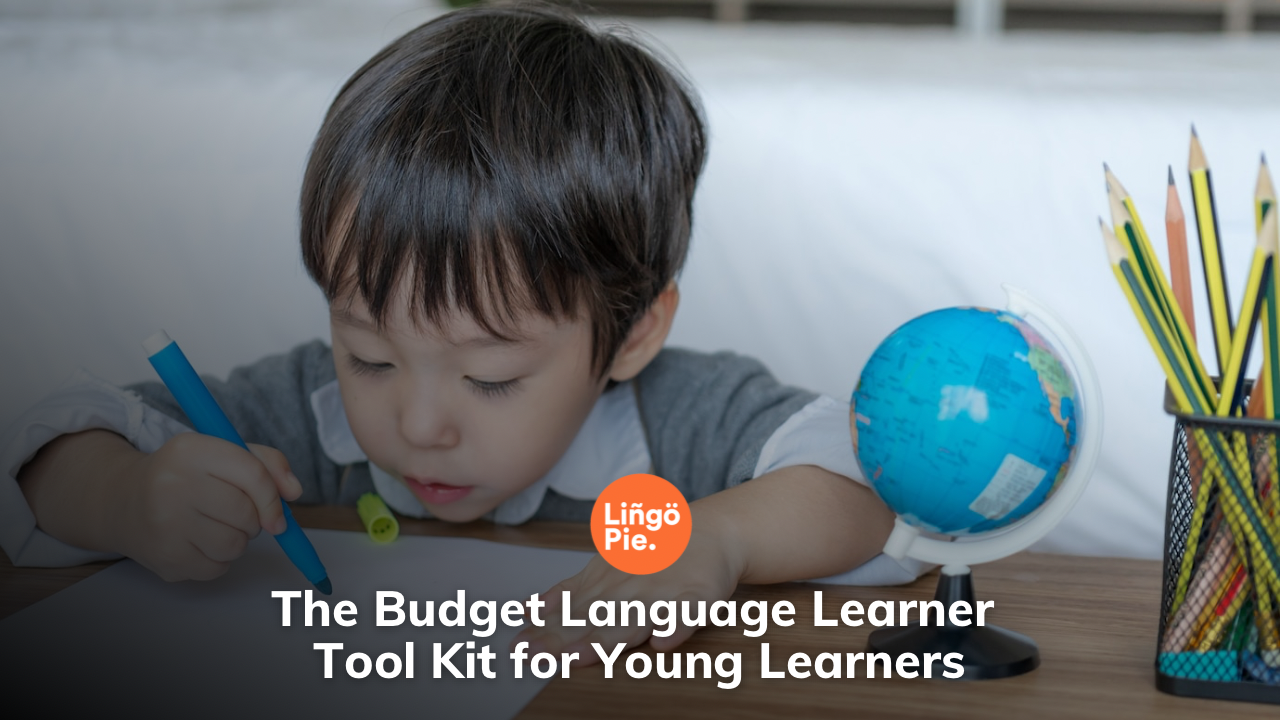
The Budget Language Learner Tool Kit for Young Learners

Global Perspectives and Multilingualism: Language Learning with Manu Chao's Songs
You might also like.

Scientific Reasons Why You Should Learn A Language Through Poems

10 Simple Tips To Practice A Language In A Foreign Country

How To Become A Polyglot: Building A Multilingual Routine In 8 Easy Tips

Language Learning Toolbox: Powerful Tools for Efficient Acquisition
Get the secret guide to language learning with tv and music for free, browse posts by popular tags.
Bilingual Education - Definition, Types, Characteristics | Why is Bilingual Education Important?
June 22, 2022 by Prasanna
Bilingual education is nothing but teaching the academic syllabus to students in two different languages. Usually, educators teach students in their native language and second language in the classroom. Bilingual education helps students to develop multiple skills in the second language. Continue reading to know the importance of bilingualism, its history, types, advantages and disadvantages in academics from this page.
What is Bilingual Education?
Benefits of bilingual education, types of bilingual education, what are the challenges of bilingual education, bilingualism pros and cons, faqs on bilingual education.
Bilingual Education is the process of using two different languages in classroom instructions. It is a two-way or dual language immersion. The main intention of this program is to teach students the native (English) language along with the second (non-English) language.
During this systematic program, the teachers teach the academic subjects in both languages as per the instructions in the academic program. After the completion of the course, the students are able to speak, read, write, and listen the second language.
Bilingualism not only helps students master both languages but also improves their understanding of every culture. The goal is students should be able to communicate in both languages.
In the modern world, bilingual education plays an important role and offers various benefits to the younger generations. It enables students to learn two languages. The potential benefits are increased mental flexibility, improved intercultural skills, and increased opportunities for global exchange and trade.
Global Citizens People who learn two languages are invaluable in today's world. They can find employment opportunities throughout the world.
Psychological Benefits Another benefit is you can translate words from one language to another easily. So that students can understand the concept and they can act as translators between the two.
Language Proficiency Students are able to communicate in two languages perfectly.
Understanding Cultures Bilingual is about understanding cultures. People combine, and blend aspects of the cultures that are living, making linguistics, and cultures as per the needs.
Career Opportunities People who have bilingual education have more career opportunities than monolingual. They can get employment in both languages across the world.
Improved Memory The students who study bilingual education score the highest marks compared to monolingual.
Also, Check
- Affordable Universities in USA for International Students
- How to Study for MCAT
Here mentioned are the several different types of bilingual education program models.
Immersion Bilingual Education Immersion is a type of bilingual education where subjects are taught in the student's second language. Here the subject is entirely taught in the second language. There are different facets of immersion in schools.
Transitional Bilingual Education It involves education in the student's native language. When the student's English proficiency is deemed satisfactory.
English as a Second Language In a few schools, the English language is selected as the second language. Students are learning English as a second language because English has been assigned communicative status in the country.
Late-exit or Developmental Bilingual Education In this model, the education is in the student's native language for an extended duration. The main goal is to improve literacy in the primary language and transfer these skills into the second language.
Effects of mother-tongue instruction Education in their mother tongue and other languages has proven essential for their personal and educational development.
- People may have a lot of questions when considering bilingual education for their children.
- Few people see bilingual education as needed proficiency in the second language, whereas others think of it as developing skills in the second language.
- Students learning education through a second language need to be systematically supported over a period of 5 to 10 years in developing skills by using academic language.
- In few cases, bilingual education is for the whole school.
- Bilingual education is a different program and it requires researching, designing, planning, monitoring and evaluation.
Here we are providing the Bilingual Education pros and cons details.
Advantages of Bilingual Education
- It offers cultural awareness
- You may be able to work abroad
- Personal development
- Improves automatic adaption of new languages
- Improve mental strength
- May be interested to learn new things
- Gain better career options
- Easy to participate in exchange programs
Disadvantages of Bilingual Education
- You may feel difficult at the starting
- It needs more learning time
- It can be costly
- Not so many schools offer this system
- You can provide less time for other activities
- May increase stress levels of students
- Higher administrative and planning efforts
- Lack of qualified teachers
The main goal of bilingual education is to enable English language learners to become proficient in reading, speaking, and writing in the English language through literacy development and academic skills in the native language and English.
The different bilingualism characteristics are here:
- An English language development component
- High expectations for students and clear programmatic goals, and many more.
The types of bilingual education program models are immersion bilingual education, transitional bilingual education, English as a second language, effects of mother-tongue instruction, late-exit or developmental bilingual education.
Students with a bilingual education system will achieve more scores than monolinguals on the number of tests of solving tasks, non-verbal problems, and mental flexibility.

IMAGES
VIDEO
COMMENTS
Bilingual education can help students develop their English proficiency, close the gap in achievement, and have cognitive advantages. It also offers cultural and social benefits such as enriching academic experiences and career opportunities. Learn more about the benefits of bilingual education and how it relates to student learning and growth.
The following are just a few of the cognitive advantages to bilingual education: Increased ability to solve problems, think creatively and recognize patterns. Improved academic performance. Enhanced linguistic awareness and understanding of an individual's native language. Increased ability to apply concepts to novel situations.
In bilingual education, students are taught in two (or more) languages. It is distinct from learning a second language as a subject because both languages are used for instruction in different content areas like math, science, and history. The time spent in each language depends on the model. For example, some models focus on providing education in both languages throughout a student's entire ...
This paper looks at the next 25 years of education and policy making regarding students classified as English learners (EL). Given the strong research evidence on the benefits of bilingual education and need to address barriers to opportunity experienced by English learners, this paper strengthens the case for federal, state and local education policy and action that looks toward the ...
CLIL is a dual-focused teaching approach in which bilingual learners learn both content and language. • CLIL can also be used to make a foreign language programme more motivating by teaching real content (e.g. history) through the language. • Some teachers make only minimal use of the L1 in order to immerse bilingual learners in the L2.
The researchers detail the academic benefits of bilingual education, including superior achievement outcomes. These include English language development benefits, such as a greater likelihood of reclassification or exit from English Learner services. The report also highlights the benefits of home language literacy and proficiency and cites a ...
Bilingual the United Education. This brief is the first of a four-part series that focuses on bilingual education, bilingual educators, and addressing the bilingual teacher shortage in contexts across the United States. This research was commissioned by the New Jersey State Department of Education, which is committed to providing quality ...
Increase Access to Quality Bilingual Education for All: Knowing additional languages along with English is a much-needed skill that will have an enormous impact on our nation's future workforce as well as our ability to compete and engage globally. The Department is working diligently to increase access to high-quality language programs.
This chapter explores key research findings about bilingual education and the related efficacy of various approaches to teaching bilingual students. Its principal focus is on the research to date on the most common forms of bilingual education. ... has recently proposed that assessment measures incorporate students' L1s for the purpose of ...
Abstract. This chapter provides a broad overview of historical and contemporary key concepts in bilingual education while noting the ambiguous definitions and varying purposes and sometimes conflicting aims as driven by ideologies and politics. Major contributions and work in progress are considered through traditional program models and ...
Bilingual education broadly describes a complex array of school programs with different goals and objectives for different student populations (Rubin, 1977; Trueba, 1980). In the ... A central purpose of the new "common" schools was to "Americanize" students as part of broader effort to assimilate new immigrants
Bilingualism is the study of languages in contact, typically in situations where people from different linguistic and cultural backgrounds share the same space. Bilingualism was analyzed into four levels in another paper: individual, family, societal, and school levels (McCarty, 2010b). Bilingual education is bilingualism at the school level.
Bilingual education is an umbrella terms that encompasses a range of education programs that have been designed for an even wider range of children and a host of special circumstances. Essentially, bilingual education refers to any school program in which more than one language is used in the curriculum to teach non-language academic subject ...
Bilingual education is the delivery of academic material in two languages, one of which is usually the students' native language. Students of all ages enroll in schools and learning environments where the primary language is different from their native language; in order to keep these students on the same academic timeline as their peers ...
Abstract. This chapter explores key research findings about bilingual education and the. related ef ficacy of various approaches to teaching bilingual students. Its principal. focus is on the ...
Bilingual education involves teaching all subjects in school through two different languages and the practice of teaching children in their native language. Instruction occurs in the native language and a minority language with varying amounts of each language used in accordance with the program model. ... The purpose of bilingual education is ...
What is the purpose of bilingual education? Bilingual Intercultural Education is the modality of the educational system that guarantees the constitutional right of native peoples to receive an education that contributes to preserving and strengthening their cultural elements, language, their worldview, and identity.
Bilingual education in both Canada and the United States is an issue that has led to much discussion and debate. In Canada, bilingual instruction, whether as immersion or as heritage language instruction, has been more widely accepted than in the United States. ... The first one is particularly interesting for the purpose of this paper because ...
These advantages can open doors in the worlds of work and education. Bilingualism has been found to enhance memory and attention span. The constant mental exercise of switching between languages strengthens the brain's cognitive processes, resulting in improved memory formation and retrieval. Moreover, bilingual individuals exhibit enhanced ...
Bilingual Education Act (BEA), U.S. legislation (January 2, 1968) that provided federal grants to school districts for the purpose of establishing educational programs for children with limited English-speaking ability.It was the first time that the U.S. government officially acknowledged that these students need specialized instruction.
Bilingual education is the process of teaching students in two different languages in the classroom. It helps them develop multiple skills in the second language and improve their intercultural understanding and global citizenship. Learn the purpose, history, advantages and disadvantages of bilingual education from this page.
What is the purpose of the bilingual education program? Bilingual education programs are designed to make grade level academic content accessible to emergent bilingual students through the development of literacy and academic skills in the child's primary/partner and English. The academic, linguistic, and cultural backgrounds
Bilingual Education. Bilingual Education is an educational approach that aims to provide instruction in two languages, typically the native language of the students and another language, such as English, in order to help students become proficient in both languages. This approach is used in various educational settings around the world and is designed to benefit students who come from ...